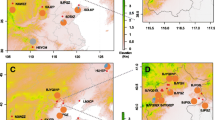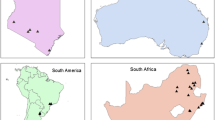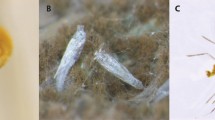Abstract
We reconstructed the phylogeography of European populations of Monochamus galloprovincialis (Coleoptera, Cerambycidae), the European vector of the pinewood nematode, Bursaphelenchus xylophilus. This study investigated the Quaternary history of M. galloprovincialis and tested whether environmental parameters and/or host tree species influenced the genetic structure of M. galloprovincialis populations. Twelve polymorphic microsatellite loci and a Bayesian analysis were applied to 1098 individuals of M. galloprovincialis from 45 European locations. The continental populations formed five main genetic clusters, typical of postglacial recolonization routes observed for temperate biota associated with pine trees. The distribution of clusters formed boundaries along mountain ranges, indicating a potential role of elevation as a large-scale barrier to dispersal for this species. The correlation between environmental parameters and the distribution of genetic clusters of M. galloprovincialis was investigated using a partial redundancy analysis and showed an effect of precipitation rather than host tree species. From an applied perspective, these results suggest that climatic conditions and elevation may constitute barriers to the dispersal of M. galloprovincialis and the associated PWN.

Similar content being viewed by others
References
Auger-Rozenberg MA, Torres-Leguizamon M, Courtin C, Rossi JP, Kerdelhué C (2015) Incongruent evolutionary histories of two parasitoids in the Mediterranean Basin: influence of host specialization and ecological characteristics. J Biogeogr. doi:10.1111/jbi.12495
Barbéro M, Loisel R, Quézel P, Richardson DM, Romane F (1998) Pines of the Mediterranean Basin. In: Richardson DM (ed) Ecology and biogeography of Pinus. Cambridge University Press, Cambridge, pp 153–170
Bucci G, Gonzalez-Martinez SC, Le Provost G, Plomion C, Ribeiro MM (2007) Range-wide phylogeography and gene zones in Pinus pinaster Ait. revealed by chloroplast microsatellite markers. Mol Ecol 16:2137–2153
Burban C, Petit RJ, Carcreff E, Jactel H (1999) Rangewide variation of the maritime pine bast scale Matsucoccus feytaudi Duc. (Homoptera: Matsucoccidae) in relation to the genetic structure of its host. Mol Ecol 8:1593–1602
Carrion JS (2002) Patterns and processes of Late Quaternary environmental change in a montane region of southwestern Europe. Quat Sci Rev 21:2047–2066
Chapuis MP, Estoup A (2007) Microsatellite null alleles and estimation of population differentiation. Mol Biol Evol 24:621–631
David G, Giffard B, Piou D, Jactel H (2014) Dispersal capacity of Monochamus galloprovincialis, the European vector of the pine wood nematode, on flight mills. J Appl Entomol 138:566–576
Development Core Team R (2012) R: a language and environment for statistical computing. R Foundation for Statistical Computing, Vienna
Dupas S, Le Ru B, Branca A, Faure N, Gigot G et al (2014) Phylogeography in continuous space: coupling species distribution models and circuit theory to assess the effect of contiguous migration at different climatic periods on genetic differentiation in Busseola Fusca (Lepidoptera: Noctuidae). Mol Ecol 23:2313–2325
Earl DA, VonHoldt BM (2012) STRUCTURE HARVESTER: a website and program for visualizing STRUCTURE output and implementing the Evanno method. Conserv Genet Res 4:359–361
Eckert AJ, Hall BD (2006) Phylogeny, historical biogeography, and patterns of diversification for Pinus (Pinaceae): phylogenetic tests of fossil-based hypotheses. Mol Phylogenet Evol 40:166–182
Erber D, Franquinho Aguiar AM (1996) New and remarkable species of the coleopterous fauna of Madeira. Bol Mus Mun Fun 48:41–62
Evanno G, Regnaut S, Goudet J (2005) Detecting the number of clusters of individuals using the software structure: a simulation study. Mol Ecol 14:2611–2620
Evans HF (2014). Rapport final du projet Européen REPHRAME, p 57. http://www.rephrame.eu/pwn.php. Access December 2016
Fady B (2012) Biogeography of neutral genes and recent evolutionary history of pines in the Mediterranean Basin. Ann For Sci 69:421–428
Gallego D, Sanchez-Garcia FJ, Mas H, Campo MT, Lencina JL (2012) Estudio de la capacidad de vuelo a larga distancia de Monochamus galloprovincialis (Oliver 1795) (Coleoptera: Cerambycidae) en un mosaico agro-forestal. Bol Sanid Veg Plagas 38:109–123
Gomez A, Lunt DH (2006) Refugia within refugia: patterns of phylogeographic concordance in the Iberian Peninsula. In: Weiss S, Ferrand N (eds) Phylogeography of southern European refugia—evolutionary perspectives on the origins and conservation of European biodiversity. Kluwer, Dordrecht, pp 155–188
Gomez A, Vendramin GG, Gonzalez-Martinez SC, Alia R (2005) Genetic diversity and differentiation of two Mediterranean pines (Pinus halepensis Mill. and Pinus pinaster Ait.) along a latitudinal cline using chloroplast microsatellite markers. Divers Distrib 11:257–263
Goudet JJ (1995) FSTAT (Version 1.2): a computer program to calculate F-statistics. J Hered 86:485–486
Haran J, Roux-Morabito G (2014) Development of 12 microsatellites loci for the longhorn beetle Monochamus galloprovincialis (Coleoptera Cerambycidae), vector of the pinewood nematode in Europe. Conserv Genet Res 6:975–977
Haran J, Koutroumpa F, Magnoux E, Roques A, Roux G (2015a) Ghost mtDNA haplotypes generated by fortuitous NUMTs can deeply disturb infra-specific genetic diversity and phylogeographic pattern. J Zool Syst Evol Res. doi:10.1111/jzs.12095
Haran J, Roques A, Bernard A, Robinet C, Roux G (2015b) Altitudinal barrier to the spread of an invasive species: could the Pyrenean chain slow the natural spread of the pinewood nematode? PLoS ONE 10(7):e0134126
Heger T, Mitchell EAD, Leander BS (2013) Holarctic phylogeography of the testate amoeba Hyalosphenia Papilio (Amoebozoa: Arcellinida) reveals extensive genetic diversity explained more by environment than dispersal limitation. Mol Ecol 22:5172–5184
Hellrigl KG (1971) La bionomie des espèces de Monochamus (Coleoptera, Cerambycidae) et leur importance pour la sylviculture et l’économie du bois. Redia 52:367–511
Hernandez R, Ortiz A, Pérez V, Gil JM, Sanchez G (2011) Monochamus galloprovincialis (Olivier, 1795) (Coleoptera: Cerambycidae), comportamiento y distancias de vuelo. Bol Sanid Veg Plagas 37:79–96
Hewitt GM (1999) Post-glacial re-colonization of European biota. Biol J Linn Soc 68:87–112
Hijmans RJ, Cameron SE, Parra JL, Jones PG, Jarvis A (2005) Very high resolution interpolated climate surfaces for global land areas. Int J Climatol 25:1965–1978
Husemann M, Schmitt T, Zachos FE, Ulrich W, Habel JC (2014) Palaearctic biogeography revisited: evidence for the existence of a North African refugium for Western Palaearctic biota. J Biogeogr 41:81–94
Kalinowski S (2005) HP-RARE 1.0: a computer program for performing rarefaction on measures of allelic richness. Mol Ecol Notes 5:187–189
Koutroumpa FA, Vincent B, Roux-Morabito G, Martin C, Lieutier F (2008) Fecundity and larval development of Monochamus galloprovincialis (Coleoptera Cerambycidae) in experimental breeding. Ann For Sci 65:707
Koutroumpa FA, Lieutier F, Roux-Morabito G (2009a) Incorporation of mitochondrial fragments in the nuclear genome (Numts) of the longhorned beetle Monochamus galloprovincialis (Coleoptera, Cerambycidae). J Zool Syst Evol Res 47:141–148
Koutroumpa FA, Salle A, Lieutier F, Roux-Morabito G (2009b) Feeding and oviposition preferences of Monochamus galloprovincialis on its main hosts Pinus sylvestris and Pinus pinaster. Entomol Hell 18:35–46
Koutroumpa FA, Rougon D, Bertheau C, Lieutier F, Roux-Morabito G (2013) Evolutionary relationships within European Monochamus (Coleoptera: Cerambycidae) highlight the role of altitude in species delineation. Biol J Linn Soc 109:354–376
Kuroda K (2008) Physiological incidences related to symptom development and wilting mechanism. In: Zhao BG, Futai K, Sutherland JR, Takeuchi Y (eds) Pine wilt disease. Tokyo, Springer Japan, pp 204–222
Kutywayo D, Chemura A, Kusena W, Chidoko P, Mahoya C (2013) The impact of climate change on the potential distribution of agricultural pests: the case of the coffee white stem borer (Monochamus leuconotus P.) in Zimbabwe. PLoS ONE 8(8):e73432
Legendre P, Legendre L (2012) Numerical Ecology. Elsevier, Amsterdam
Lu M, Wingfield MJ, Gillette NE, Mori SR, Sun JH (2010) Complex interactions among host pines and fungi vectored by an invasive bark beetle. New Phytol 187:859–866
Mas H, Hernandez R, Villaroya G, Sanchez G, Pérez-Laorga E et al (2013) Dispersal behavior and long distance flight capacity of Monochamus galloprovincialis (Olivier 1795). Berichte aus dem Julius-Kuehn-Institut, 169: 22. In: Schröder T (ed) pine wilt disease conference 2013. Scientific Conference IUFRO, unit 7.02.10 and FP7 EU-Research Project REPHRAME. 15th–18th Oct 2013, Braunschweig: Berichte aus dem Julius Kühn-Institut
Mota M, Braasch H, Bravo MA, Penas AC, Burgermeister W et al (1999) First report of Bursaphelenchus xylophilus in Portugal and in Europe. Nematology 1:727–734
Naves P, de Sousa E (2009) Threshold temperatures and degree-day estimates for development of post-dormancy larvae of Monochamus galloprovincialis (Coleoptera: Cerambycidae). J Pest Sci 82:1–6
Naves P, Sousa E, Quartau J (2006) Feeding and oviposition preferences of Monochamus galloprovincialis for some conifers under laboratory conditions. Entomol Exp Appl 18:99–104
Naves PM, Camacho S, de Sousa E, Quartau JA (2007) Transmission of the pine wood nematode Bursaphelenchus xylophilus through oviposition activity of Monochamus galloprovincialis (Coleoptera: Cerambycidae). Entomol Fenn 18:193–198
Oksanen J, Blanchet FG, Kindt R, Legendre P, Minchin PR, et al (2016) Vegan: community ecology package. R package version 2.3-3. http://CRAN.R-project.org/package=vegan
Olden JD, LeRoy Poff N, Douglas MR, Douglas ME, Fausch KD (2004) Ecological and evolutionary consequences of biotic homogenization. Trends Ecol Evol 19:18–24
Peakall R, Smouse PE (2012) GenAlEx 6.5: genetic analysis in Excel. Population genetic software for teaching and research-an update. Bioinformatics 28:2537–2539
Pimentel D, McNair S, Janecka J et al (2001) Economic and environmental threats of alien plant, animal, and microbe invasions. Agric Ecosyst Environ 84:1–20
Potter C, Harwood T, Knight J, Tomlinson I (2011) Learning from history, predicting the future: the UK Dutch Elm Disease outbreak in relation to contemporary tree disease threats. Philos Trans R Soc Lond B Biol Sci 366:1966–1974
Pritchard JK, Stephens M, Donnelly P (2000) Inference of population structure using multilocus genotype data. Genetics 155:945–959
Pysek P, Sadlo J, Mandak B, Jarosik V (2003) Czech alien flora and the historical pattern of its formation: what came first to Central Europe? Oecologia 135:122–130
Raymond M, Rousset F (1995) GENEPOP (version 1.2): population genetics software for exact tests and ecumenicism. J Hered 86:248–249
Robertson L, Cobacho AS, Escuer M, Esparrago G et al (2011) Incidence of the pinewood nematode Bursaphelenchus xylophilus Steiner and Buhrer, 1934 (Nickle, 1970) in Spain. Nematology 13:755–757
Roques A, Kenis M, Lees D, Lopez-Vaamonde C, Rabitsch W, Rasplus JY, Roy D (eds) (2010) Alien terrestrial arthropods of Europe. BioRisk, special issue, 4. Sofia, Pensoft Publishers, p 1028
Rousselet J, Zhao RX, Argal D, Simonato M, Battisti A et al (2010) The role of topography in structuring the demographic history of the pine processionary moth, Thaumetopoea pityocampa (Lepidoptera: Notodontidae). J Biogeogr 37:1478–1490
Schmitt T (2007) Molecular biogeography of Europe: pleistocene cycles and postglacial trends. Front Zool. doi:10.1186/1742-9994-4-1
Sexton JP, Hangartner SB, Hoffmann AA (2014) Genetic isolation by environment or distance: which pattern of gene flow is most common? Evolution 68:1–15
Shirk AJ, Wallin DO, Cushman SA, Rice CG, Warheit KI (2010) Inferring landscape effects on gene flow: a new model selection framework. Mol Ecol 19:3603–3619
Shoda-Kagaya E (2007) Genetic differentiation of the pine wilt disease vector Monochamus alternatus (Coleoptera: Cerambycidae) over a mountain range—revealed from microsatellite DNA markers. Bull Entomol Res 97:167–174
Soliman T, Mourits MCM, van der Werf W, Hengeveld GM, Robinet C et al (2012) Framework for modelling economic impacts of invasive species, applied to pine wood nematode in Europe. PLoS ONE 7(9):e45505
Storey JD (2002) A direct approach to false discovery rates. J R Stat Soc Series B Stat Methodol 64:479–498
Taberlet P, Fumagalli L, Wust-Saucy AG, Cosson JF (1998) Comparative phylogeography and postglacial colonization routes in Europe. Mol Ecol 7:453–464
Tavares C, Roques A, Courtial B, Branco M, Jactel H, Lopez-Vaamonde C (2014) Phylogeography of the ladybird Iberorhyzobius rondensis, a potential biological control agent of the invasive alien pine bast scale Matsucoccus feytaudi. Biocontrol. doi:10.1007/s10526-014-9622-7
Torres-Vila L, Zugasti C, De-Juan JM, Olivia MJ, Montero C, Mendiola FJ et al (2015) Mark-recapture of Monochamus galloprovincialis with semiochemicalbaited traps: population density, attraction distance, flight behaviour and mass trapping efficiency. Forestry 88:224–236
Vicente C, Espada M, Vieira P, Mota M (2012) Pine Wilt Disease: a threat to European forestry. Eur J of Plant Pathol 133:89–99
Vives E (2000) Coleoptera Cerambycidae. In: Iberica Fauna (ed) Museo Nacional de Ciencias Naturales. Museo Nacional de Ciencias Naturales, Madrid
Wallin H, Schroeder M, Kvamme T (2013) A review of the European species of Monochamus Dejean, 1821 (Coleoptera, Cerambycidae—with a description of the genitalia characters. Nor J Entomol 60:11–38
Acknowledgements
We would like to thank all the co-workers and colleagues of REPHRAME (Development of improved methods for detection, control and eradication of pine wood nematodes in support of EU Plant Health Policy) for making this study possible through their help with M. galloprovincialis sampling. Our thanks go in particular to J. Pajares, E. de Sousa, P. Naves, L. Bonifacio, M. Glavendekic, H. Jactel, G. David, D. Doichev, M. Ben Jaama, T. Schroeder, G. Hoch, M. Dautbasic, N. Lackovic, M. Schroeder, I. Papazova, R. Tomov, T. Manole, V. Kramarets, I. Matsiakh, G. Csoka, A. Hopf, A. Battisti, M. Avci, and A.M. Chappe (ANSES, France). We also wish to thank the County Administrative Board of Gotland for permission to trap beetles in the National Park of Gotska Sandön. We warmly thank M.A. Auger-Rozenberg for useful comments on early versions of this manuscript and Peter Biggins for English editing. This work was funded by the European project REPHRAME KBBE.2010.1.4-09 (FP7 Project, Analysis of the potential of the pine wood nematode (Bursaphelenchus xylophilus) to spread, survive and cause pine wilt in European coniferous forests in support of EU plant health policy) and a COST-PERMIT grant (COST-STSM-FP1002-14177). JH was funded by the French Ministry of Research and Education.
Author information
Authors and Affiliations
Corresponding author
Ethics declarations
Conflict of interest
We declare no conflict of interest for the present study, for all the authors. Specimen samples were taken in agreement with local authorities and did not involve endangered or protected species.
Additional information
Communicated by C. Stauffer.
Electronic supplementary material
Below is the link to the electronic supplementary material.
10340_2017_878_MOESM1_ESM.pdf
Appendix 1: Map of Monochamus galloprovincialis sampling site distribution (Olivier 1795). Black dots correspond to populations used for partial redundancy analysis (pRDA); white dots correspond to the remaining sampling sites. The green background refers to elevation. (PDF 278 kb)
10340_2017_878_MOESM2_ESM.xlsx
Appendix 2: Pairwise unbiased F st estimates and significance of differentiation between the 45 populations of Monochamus galloprovincialis analyzed (***: p < 0.001, **: p < 0.01, **: p < 0.05, NS: nonsignificant). Bold values refer to F st estimates above 0.2. (XLSX 26 kb)
10340_2017_878_MOESM3_ESM.tif
Appendix 3: Evolution of Delta-K statistic among an increasing number of clusters (K) obtained through STRUCTURE analysis.The microsatellite dataset of the 45 populations of Monochamus galloprovincialis used in this study will be submitted to a general repository (Dryad). (TIFF 2930 kb)
Rights and permissions
About this article
Cite this article
Haran, J., Rousselet, J., Tellez, D. et al. Phylogeography of Monochamus galloprovincialis, the European vector of the pinewood nematode. J Pest Sci 91, 247–257 (2018). https://doi.org/10.1007/s10340-017-0878-4
Received:
Revised:
Accepted:
Published:
Issue Date:
DOI: https://doi.org/10.1007/s10340-017-0878-4




